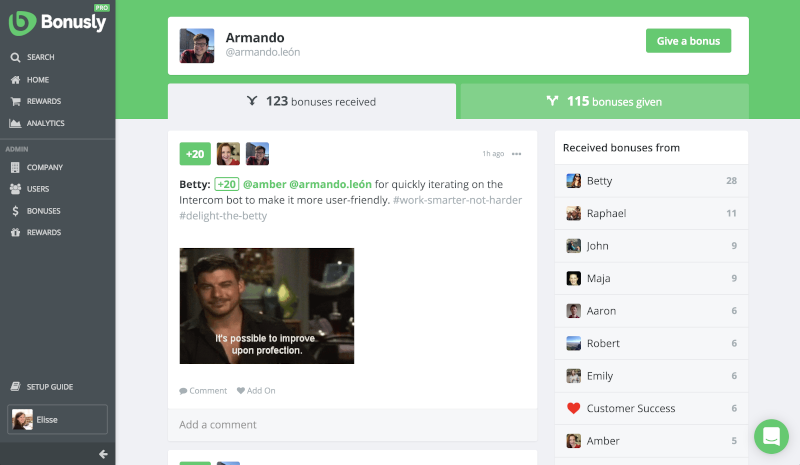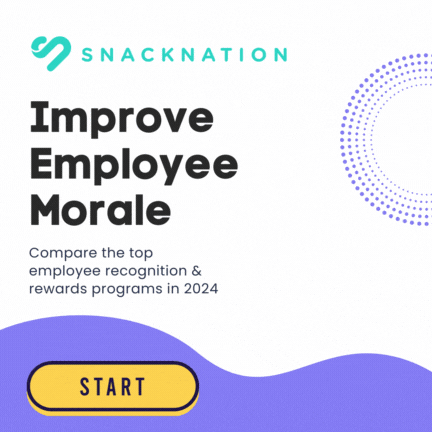Employee service recognition is a way for companies to acknowledge and appreciate the contributions and initiatives of their employees.
This corporate culture hack involves publicly recognizing and rewarding employees for their dedication, hard work, and commitment to the organization to motivate them.
Recognizing employee service and providing employee rewards is crucial for boosting employee morale, increasing job satisfaction, and creating a positive work culture.
“71% of employees would be less likely to leave their organization if they were recognized more frequently.” — NectarHR Click To Tweet
As employers, it is essential to make employee service recognition a regular practice in your organizations. Show appreciation for your employees and create a positive work environment together!
Buckle up and keep on reading to discover more!
Page Contents (Click To Jump)
What Is Employee Service Recognition?
Employee service recognition, or employee recognition programs, in general, go beyond just recognizing an employee’s tenure with the company.
They involve acknowledging their hard work, dedication, and contributions toward the organization’s success, which affects the employee experience. This sets it apart from other employee recognition examples, such as performance-based or safety-based recognition. Service recognition focuses on the individual’s commitment and loyalty to the company, making them feel valued and motivated to continue their efforts. It also helps foster a positive work culture and boosts employee morale and job satisfaction.
There are different types of employee recognition gifts, which include motivational quotes, personal notes or incentives, recognition templates, service award programs or years of service awards, service anniversaries, service milestones, employee anniversaries, employee recognition walls, or gift cards.
Benefits of Employee Service Recognition
✅ Boosts Employee Morale
Recognizing employees’ efforts can boost their motivation, morale, and job satisfaction, positively affecting the employee contributions to the company.
✅ Improves Employee Retention
When employees feel appreciated and valued, they are more likely to stay with the company for a longer time, resulting in higher employee years of service.
✅ Creates a Positive Work Culture
A culture of recognition can improve employee relationships and create a positive work environment.
✅ Increases Productivity
Recognized employees tend to be more engaged, increasing productivity and performance.
✅ Encourages Loyalty
Recognizing employees’ loyalty can encourage them to remain dedicated and committed to the organization.
Best Employee Service Recognition Strategies
1. Personalized Recognition Awards
Tailor employee awards to match the individual’s contributions and personality. Utilize meaningful symbols or items that resonate with the employee’s achievements or interests. This personal touch shows that the company values their unique contributions and understands them personally.
👉 Tip: Collect information about employees’ preferences, achievements, and milestones. Design awards or ceremonies to highlight the uniqueness of each recipient’s contributions.
2. Milestone Celebrations
Acknowledge significant milestones like work anniversaries, length of service, project completions, or personal milestones with celebrations. Create events or acknowledgments that reflect the significance of the milestone.
This is a great way to show appreciation and recognition for the hard work put in by your team members.
👉 Tip: Plan events or acknowledgments well in advance to ensure meaningful recognition. Involve team members in the celebration to foster community and shared achievement.
3. Peer-to-Peer Recognition Programs
Establish systems where employees can recognize each other’s contributions and successes. Encourage a culture of appreciation across all levels of the organization.
Peer-to-peer recognition programs often feel even more meaningful than the praise coming from top-down.
👉 Tip: Implement a simple yet flexible platform for peer recognition, such as a digital kudos board or recognition software. Regularly highlight peer-recognized achievements in company meetings or newsletters.
4. Professional Development Opportunities
Offer targeted professional development opportunities as a form of recognition. Link recognition to career advancement, skill development, or personal growth opportunities.
Employees are more likely to be motivated and engaged when they see a clear connection between their recognition and career goals.
👉 Tip: Understand employees’ career goals and align recognition with opportunities that support these goals. Announce professional development recognitions in a way that highlights the employee’s potential and achievements.
5. Customized Rewards and Incentives
Provide rewards and incentives customized to the individual employee’s preferences and needs. Move beyond traditional monetary bonuses to include experiences, time off, or items of personal interest.
Create a rewards system that encourages and recognizes individual contributions rather than focusing solely on team performance.
👉 Tip: Survey employees to understand what forms of employee rewards and incentives they value most. Ensure that the reward system is flexible enough to accommodate various preferences and interests.
Employee Service Recognition Tools
1. Bonusly
Bonusly is a recognition and rewards platform that allows employees to give each other points for their contributions, which can then be redeemed for various rewards. Create a happier, more engaged workplace that boasts a culture of recognition and appreciation. In addition to boosting employee morale, recognition programs like Bonusly have improved retention rates and overall productivity.
🏅 Why this is an effective employee service recognition tool: Bonusly helps employees feel valued and motivated to contribute more. It also offers many rewards, making the recognition process more personalized and meaningful for employees.
2. WorkTango
WorkTango is an employee engagement software that offers a variety of recognition and rewards tools, including peer-to-peer recognition, pulse surveys, and feedback features. The platform aims to help organizations build a positive workplace culture by giving employees a voice and promoting employee recognition.
🏅 Why this is an effective employee service recognition tool: WorkTango allows for continuous feedback and recognition from colleagues and managers, creating a positive feedback loop for employees. It also offers insights and analytics to measure the impact of recognition on employee engagement and retention. This makes it an effective tool for enhancing employee service recognition in organizations.
3. NectarHR

NectarHR is a cloud-based employee recognition and engagement platform that offers personalized and timely recognition for employees.
🏅 Why this is an effective employee service recognition tool: NectarHR facilitates real-time, personalized recognition from peers and managers, promoting a culture of continuous appreciation. It also provides data and analytics to track the impact of recognition on employee engagement and retention. This is why it is an effective tool.
4. Awardco
An all-in-one employee recognition and rewards platform that allows for peer-to-peer recognition, company-wide awards, and incentives.
🏅 Why this is an effective employee service recognition tool: Awardco provides insights into employee engagement and retention, giving your team the ability to make adjustments and make the workplace better each day!
5. Motivosity
Motivosity is an employee recognition and engagement platform with a points system for peer-to-peer recognition, rewards, and feedback.
This platform fosters a positive company culture by encouraging employees to show appreciation for each other’s work and contributions.
🏅 Why this is an effective employee service recognition tool: Motivosity builds the framework to instill daily expressions of gratitude.
Tips for Effective Employee Service Recognition
 👍 Personalize the Recognition
👍 Personalize the Recognition
Tailor recognition to fit the individual achievements and preferences of your employees. Personalized awards show that you pay attention to their unique contributions and value them as individuals.
👍 Make It Timely
Acknowledge contributions and milestones as they happen. Prompt recognition reinforces positive behaviors and shows that management is attentive and appreciative of employee efforts in real-time.
👍 Public Recognition
Celebrate achievements in a public setting, such as company meetings or through internal newsletters. Public acknowledgment not only boosts the recipient’s morale but also sets a positive example for the rest of the team.
👍 Incorporate Peer Recognition
Encourage a culture where employees can recognize each other’s contributions. Peer-to-peer recognition programs can enhance team dynamics and promote a more inclusive recognition culture.
👍 Offer Meaningful Rewards
Beyond verbal appreciation, provide rewards that hold real value for the recipients. This could range from extra time off, gift cards, to professional development opportunities. Ensure the rewards match the achievement’s significance.
👍 Track and Measure Success
Implement a system to track the effectiveness of your recognition program. Surveys, employee feedback, and retention rates can provide insights into how well your recognition efforts are received and areas for improvement.
👍 Incorporate Values and Goals
Align the recognition program with your company’s values and long-term goals. Recognizing behaviors that contribute to these objectives reinforces their importance and encourages others to act in ways that support the company’s mission.
👍 Variety in Recognition
Utilize various recognition forms, from formal awards ceremonies to casual thank you notes. A mix of formal and informal recognition can cater to different employee preferences and occasions.
👍 Leadership Involvement
Ensure that leadership actively participates in the recognition process. Leadership acknowledgment significantly enhances the impact of recognition efforts.
👍 Continuous Improvement
Regularly review and adjust the recognition program based on feedback and changing needs. An adaptable program ensures ongoing relevance and effectiveness.
People Also Ask These Questions About Employee Service Recognition
Q: What are the challenges in implementing an employee service recognition program?
- A: Some challenges in implementing an employee service recognition program may include a lack of budget, limited resources, and difficulty measuring ROI. Ensuring inclusivity and fairness in the recognition process can also be challenging.
Q: How often should employees be recognized for their service to be meaningful?
- A: The frequency of recognition may vary depending on the company culture and individual preferences. However, regular and timely recognition is typically more impactful than infrequent or sporadic recognition.
Q: How can organizations measure the success and impact of their service recognition programs?
- A: To measure the success and impact of a service recognition program, organizations can track metrics such as employee engagement, retention rates, and performance indicators. They can also gather employee feedback through surveys and use data analytics to analyze the program’s effectiveness.
Q: Can employee service recognition improve company culture, and if so, how?
- A: Yes, employee service recognition can significantly improve company culture by creating a more positive and inclusive work environment. It promotes a culture of appreciation and encourages employees to go above and beyond in their roles. This can lead to increased employee morale, motivation, and overall job satisfaction, ultimately contributing to a stronger and more cohesive company culture.














 👍 Personalize the Recognition
👍 Personalize the Recognition





